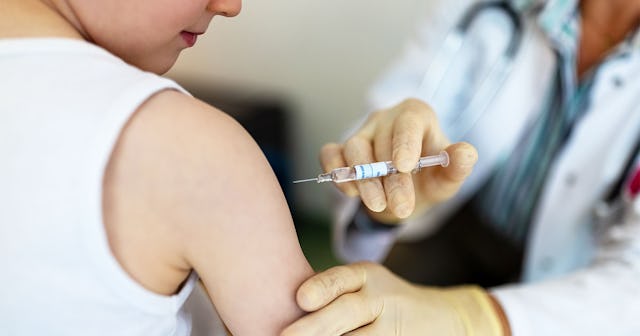Kids Play A Vital Role In Achieving COVID Herd Immunity

With the rollout of the vaccines (slowly) beginning across the United States, actual discussion about returning to normal and herd immunity can begin. Dr. Fauci has said that we’d need 75-85% of the population to have immunity to COVID-19 in order to stop the pandemic. Or even higher, given how the virus is becoming more transmissible.
And we won’t be able to achieve those high levels of immunity without also vaccinating the kids.
Vaccines for adults are a no-brainer, in my opinion. COVID is deadly, and when it’s not deadly, it can be devastating and life-changing. We know that COVID-19 affects certain populations more than others, but that also, it sometimes chooses its victims at random. We know that an untold number of folks become COVID-longhaulers. And we know that vaccines are safe. As a result—healthcare professionals can state with a fair amount of certainty that the risks of COVID-19 infection far outweigh the risks of vaccination.
But the scale of risks and benefits with kids looks different to many people. Children can become infected with COVID, but they are largely asymptomatic or have mild symptoms. In some very rare cases, pediatric patients can develop a frightening condition known as multisystem inflammatory syndrome (MIS-C), but it’s treatable and again—quite rare. As a result, the decision to vaccinate might not be as much of a no-brainer to many—the risk to benefit ratio looks different.
But that short-term risk-benefit ratio isn’t the only consideration to keep in mind when thinking about vaccinating kids against COVID-19.
Kinga Krzeminska/Getty
Kids will (eventually, one day hopefully in the not-so-distant-future) return to school, and hopefully a school where kids can play outside during recess and be kids without the stress of pandemic precautions hanging over them. If the kids are vulnerable to infection because they haven’t been vaccinated, then even if the adults in school are vaccinated, school days turn into events that looks a lot like “mass gatherings of unvaccinated people,” says Jason Newland, a pediatrician at Washington University in an article for The Atlantic. This will result in a high number of infections, which will disproportionately impact kids with underlying conditions or loved ones at home who are not yet vaccinated, says Newland. This means the virus continues circulating in a meaningful way.
The bottom line, argues Robert M. Jacobson, medical director for the Population Health Science Program at Mayo Clinic’s Robert D. and Patricia E. Kern Center for the Science of Health Care Delivery, in an article for Science New For Students is, “We’re not going to be able to control the pandemic until children are vaccinated.”
Getting kids vaccinated will be vital in reaching herd immunity, but for parents who look at the risk-benefit ratio and wonder why they should take the risk of a new vaccine against a mild infection, it’s important to remember that vaccinations for kids won’t be available for a while because all the necessary studies and safety protocols will be followed. Moderna has stated that it doesn’t expect to have COVID-19 vaccine data for children younger than twelve until 2022.
Whereas with the vaccine for adults, the FDA fast-tracked the vaccine via emergency use authorization, the process for kids will be via the normal roads for vaccine approval, according to Vanderbilt’s Tina Hartert, who is leading a study on the incidence of COVID-19 in kids. That’s to say, the FDA will require six months or more of safety data from clinical trials. With that in mind, the comparison will not be mild infection against unknown vaccines risks. The risk-benefit ratio will change, because by then we will know that these vaccines are safe for children.
Malte Mueller/Getty
Vaccinating kids is also a necessary step in the short-term to help return to normal. Even if kids are only out of school for a few days with the illness, those few days mean parents need to take off work and schedules need to be disrupted. “Even those two-to-three-day illnesses can pile up,” said Jeff Gerber, a pediatrician at Children’s Hospital of Philadelphia in an interview with The Atlantic.
There are other considerations when it comes to vaccinating children. Unfortunately, COVID is probably never going to completely disappear completely, and mutations or waning immunity might mean that vaccination or boosters will be required on a regular basis. And children may become more vulnerable to COVID-19 as they reach adulthood.
When it comes to safety measures against COVID, the focus needed to be (and still needs to be) on the collective, rather than the individual, an effort to protect the most vulnerable among us. When it comes to vaccination against COVID, the same principle applies. The more of the population that is vaccinated, the more we are able to protect the vulnerable among us who are not able to be vaccinated—like infants or those at risk of allergic reactions from the vaccine. That’s where vaccinating kids becomes important. The benefit might not be directly for them in the immediate sense, but it will be for them in the collective sense.
Kids have really been among the superheroes of this pandemic. They have given up so much to protect adults. “Kids don’t always get credit for what they’ve given up,” says Jill Weatherhead Assistant Professor of Infectious Disease at Baylor College of Medicine, in an article for Science New For Students, but fortunately, “It’s going to pay off in the long run.”
Information about COVID-19 is rapidly changing, and Scary Mommy is committed to providing the most recent data in our coverage. With news being updated so frequently, some of the information in this story may have changed after publication. For this reason, we are encouraging readers to use online resources from local public health departments, the Centers for Disease Control, and the World Health Organization to remain as informed as possible.
This article was originally published on